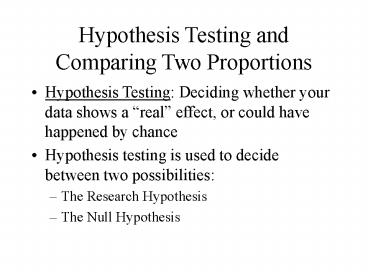Hypothesis Testing and Comparing Two Proportions PowerPoint PPT Presentation
Title: Hypothesis Testing and Comparing Two Proportions
1
Hypothesis Testing and Comparing Two Proportions
- Hypothesis Testing Deciding whether your data
shows a real effect, or could have happened by
chance - Hypothesis testing is used to decide between two
possibilities - The Research Hypothesis
- The Null Hypothesis
2
H1 and H0
- H1 The Research Hypothesis
- The effect observed in the data (the sample)
reflects a real effect (in the population) - H0 The Null Hypothesis
- There is no real effect (in the population)
- The effect observed in the data (the sample) is
just due to chance (sampling error)
3
Example Comparing Proportions
- H0 The proportions are not really different
- H1 The proportions are really different
- Example 1 Are pennies heavier on one side?
- Example 2 Do males mention footware in
personals ads more often than females do?
4
The Logic of Hypothesis Testing
- Assume the Null Hypothesis (H0) is true
- Calculate the probability (p) of getting the
results observed in your data if the Null
Hypothesis were true - If that probability is low (lt .05) then reject
the Null Hypothesis - If you reject the Null Hypothesis, that leaves
only the Research Hypothesis (H1)
5
- Assume the Null Hypothesis is true
- The coins are fair (balanced)
- Calculate the probability (p) of getting the
results observed in your data if the Null
Hypothesis were true - How often would you get 8/10 coins coming up
heads if the coins were fair? You would get 8/10
heads less than 5 of the time. - If that probability is low (lt .05) then reject
the Null Hypothesis - That is unlikely, so the Null Hypothesis must be
false. - If you reject the Null Hypothesis, that leaves
only the Research Hypothesis - We conclude that the coins are not fair
(balanced).
6
Calculating p
- How do you calculate the probability that the
observed effect is just due to chance? - Use a test statistic
- Are two proportions different? Chi-square
- Are two means different? t-test
- Are more than two means different? ANOVA or
F-test
7
The Logic is Always the Same
- Assume nothing is going on (assume H0)
- Calculate a test statistic (Chi-square, t, F)
- How often would you get a value this large for
the test statistic when H0 is true? (In other
words, calculate p) - If p lt .05, reject the null hypothesis and
conclude that something is going on (H1) - If p gt .05, do not conclude anything.
8
Demonstrating Hypothesis Testing with Chi-square
- Example 1 Testing whether coins are unbalanced
- Example 2 Testing whether men are more likely
to mention footware in personals ads than women
are. - (see Excel spreadsheet for both examples)
9
Assumptions of Chi-square Test
- Each observation must be INDEPENDENT one data
point per subject - DV is categorical (often yes/no)
- Calculations must be made from COUNTS, not
proportions or percentages - No cell should have an expected value of less
than 5
10
Using Chi-square in SPSS to compare two
proportions
- Setting up the data file copy data from excel
and paste it into SPSS data file - Performing the Chi-square test (next slide)
- Interpreting the Results (separate slide)
- Reporting the Results (separate slide)
11
Performing the Chi-Square Test
- Name the variables using the variables tab in the
SPSS data window - analyze -gt descriptive statistics -gt crosstabs
- Use arrow button to move gender into rows box
- Use arrow button to move footware into
columns box - Click Statistics box
- Check the box for Chi-square, then click
Continue - Click the Cells box.
- Under Percentages check the boxes for Row and
Column - Click OK
12
Interpreting the Results
- Case Processing Summary look for missing
data, etc. - Gender x Footware Crosstabulation shows the
counts of observations in each cell, and the
percentages within each row and within each
column. - Chi-square Tests look at Pearson chi-square
line - Value 5.33 This is the value of Chi-square
- Asymp Sig .021 This is the p value
- Compare these values to those I calculated by
hand on the excel spreadsheet
13
Reporting the Results
- Report the value of chi-square, the degrees of
freedom (df), and the p value. Also mention how
many observations there were. - EXAMPLE A greater proportion of men than women
mentioned footware in their ads (see Table 1).
Of the six ads placed by men, 83 mentioned
footware. Only 17 of the six ads placed by
women mentioned footware. This difference was
significant by a Chi-square test, Chi-square (1)
5.3, p lt .05.

